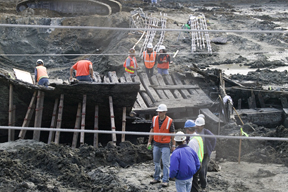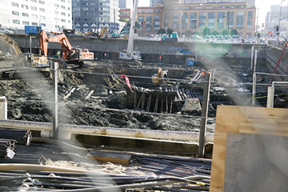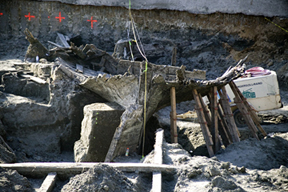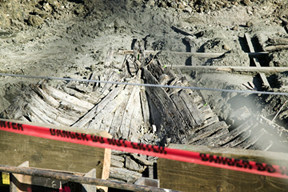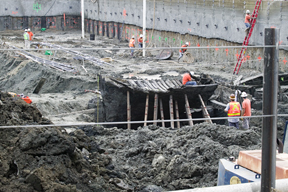RON HENGGELER |
January 29, 2006
Experts dig up nautical past of long-buried 1818 whaler
The five photos of the Candace are by Ron Henggeler. They were taken last
year on September 13th 2005. Special thanks goes to Loretta Murphy for
driving the me down to the dig site. I had just had surgery several days
before and was not allowed to drive. To see larger photos of the Candace, go to:
http://www.ronhenggeler.com/viewsII/views_index10.htm
This article appeared in the Saturday, January 28, 2006 CHRONICLE.
All credit for the writing goes to Carl Nolte of the San Francisco
Chronicle.
The bones of an old ship found by workers digging the foundations for a San Maritime archaeologists are sure the ship is the three-masted bark Candace, |
It also was one of the first American flag merchant ships to trade in the The Candace turned up in San Francisco after an ill-fated whaling voyage to It never sailed again. It was partly dismantled and eventually buried under |
Its discovery is considered significant enough that the nearly intact hull The saga of the Candace is part sea story, part detective work and partly a The bones of dozens of old ships lie under the streets of downtown San |
"Before this ship, all the ships unearthed in San Francisco have been Allan believes the discovery and preservation of the Candace is an important Allan was the consulting archaeologist called in late last summer when work The yard was significant for a number of reasons, Allen said. Hare employed |
When Allan looked at the timbers, he realized it was a small sailing ship, They consulted old San Francisco newspaper accounts, ship logs, other The two concluded that the ship was made of three kinds of oak and two kinds One big clue: Allan had found two sperm whale teeth in the bowels of the Delgado and Allan love ships, the older the better. Delgado likes to speak He quotes old articles, one from a Captain Bates, who sailed aboard the He also wrote of a storm in the Atlantic, of sighting the coast of the The Candace became a whaler later, sailing from New London, Conn. Delgado said more than 2,500 whaling voyages began from New London, as many Each trip took two years, at least, and the Candace hunted whales (using The Candace was discovered under the foundation site in September, removed "I loved finding this ship's story,'' said Delgado. "That's why I'm in this E-mail Carl Nolte at cnolte@sfchronicle.com |
Newsletters Index: 2015, 2014, 2013, 2012, 2011, 2010, 2009, 2008, 2007, 2006
Photography Index | Graphics Index | History Index
Home | Gallery | About Me | Links | Contact
© 2015 All rights reserved
The images are not in the public domain. They are the sole property of the
artist and may not be reproduced on the Internet, sold, altered, enhanced,
modified by artificial, digital or computer imaging or in any other form
without the express written permission of the artist. Non-watermarked copies of photographs on this site can be purchased by contacting Ron.
